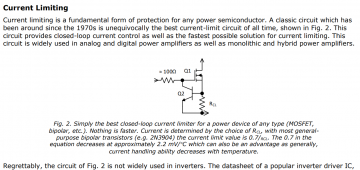Hedges
I See Electromagnetic Fields!
- Joined
- Mar 28, 2020
- Messages
- 20,682
Were you recommending this circuit for output stage of power inverters?
It will require Vbe to reach about 0.7V before operating; that is 0.7V across Rcl.
Consider a 5000W inverter with 50V from battery; 100A flows, so 70W dissipated in 7 milliohm Rcl (or multiple parallel circuits.)
That would be 1.4% of output wasted just in sense resistor. Around one quarter of entire losses of inverter.
A system might have a "50 mV" shunt. If that was a 100A shunt, would be 0.5 milliohm (but more likely to use 400A or so shunt.)

I would think a much smaller value Rcl should be used, with op-amp or comparator to boost the voltage.
I've seen a similar circuit used for a linear current regulator. In that case, for 2A it has 0.25 ohm 4-wire "kelvin" sense resistor. (efficiency was not a concern, rather accuracy and stability.)
Here's an 0.002 ohm resistor, good for 1.5W (27A) without heatsink. 10x the power with heat sink. One of these per power transistor could work.
Really good point, though, about running the inverter hot and then shorting output to test robustness.
I think much testing occurs under nominal conditions, but what you recommend is better to determine if it will enter runaway and kill itself.
It will require Vbe to reach about 0.7V before operating; that is 0.7V across Rcl.
Consider a 5000W inverter with 50V from battery; 100A flows, so 70W dissipated in 7 milliohm Rcl (or multiple parallel circuits.)
That would be 1.4% of output wasted just in sense resistor. Around one quarter of entire losses of inverter.
A system might have a "50 mV" shunt. If that was a 100A shunt, would be 0.5 milliohm (but more likely to use 400A or so shunt.)

I would think a much smaller value Rcl should be used, with op-amp or comparator to boost the voltage.
I've seen a similar circuit used for a linear current regulator. In that case, for 2A it has 0.25 ohm 4-wire "kelvin" sense resistor. (efficiency was not a concern, rather accuracy and stability.)
Here's an 0.002 ohm resistor, good for 1.5W (27A) without heatsink. 10x the power with heat sink. One of these per power transistor could work.
Really good point, though, about running the inverter hot and then shorting output to test robustness.
I think much testing occurs under nominal conditions, but what you recommend is better to determine if it will enter runaway and kill itself.
Last edited:


